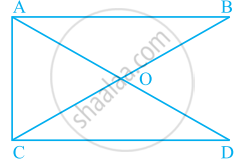Advertisements
Advertisements
प्रश्न
Can we have two obtuse angles whose sum is a complete angle? Why or why not?
उत्तर
No, ∵ The sum of two obtuse angles is greater than 180° but less than 360°. In the above example, we can see that the sum of 135° and 100° i.e., 235° is greater than 180° but less than 360°.
APPEARS IN
संबंधित प्रश्न
In a quadrilateral, define of the following Sides.
In Fig. 16.19, ABCD is a quadrilateral.
How many pairs of opposite sides are there?

In a quadrilateral ABCD, the angles A, B, C and D are in the ratio 1 : 2 : 4 : 5. Find the measure of each angle of the quadrilateral.
In ΔABC, E is the mid-point of median AD such that BE produced meets AC at F. IF AC = 10.5 cm, then AF =
In a quadrilateral ABCD, AO and BO are bisectors of angle A and angle B respectively. Show that:
∠AOB = (∠C + ∠D)
In an isosceles trapezium one pair of opposite sides are _____ to each Other and the other pair of opposite sides are _____ to each other.
If one angle of a cyclic quadrilateral is 75°, then the opposite angle is
Number of angles less than 180° in figure is ______ and their names are ______.
The number of common points in the two angles marked in figure is ______.
The common part between the two angles BAC and DAB in figure is ______.
